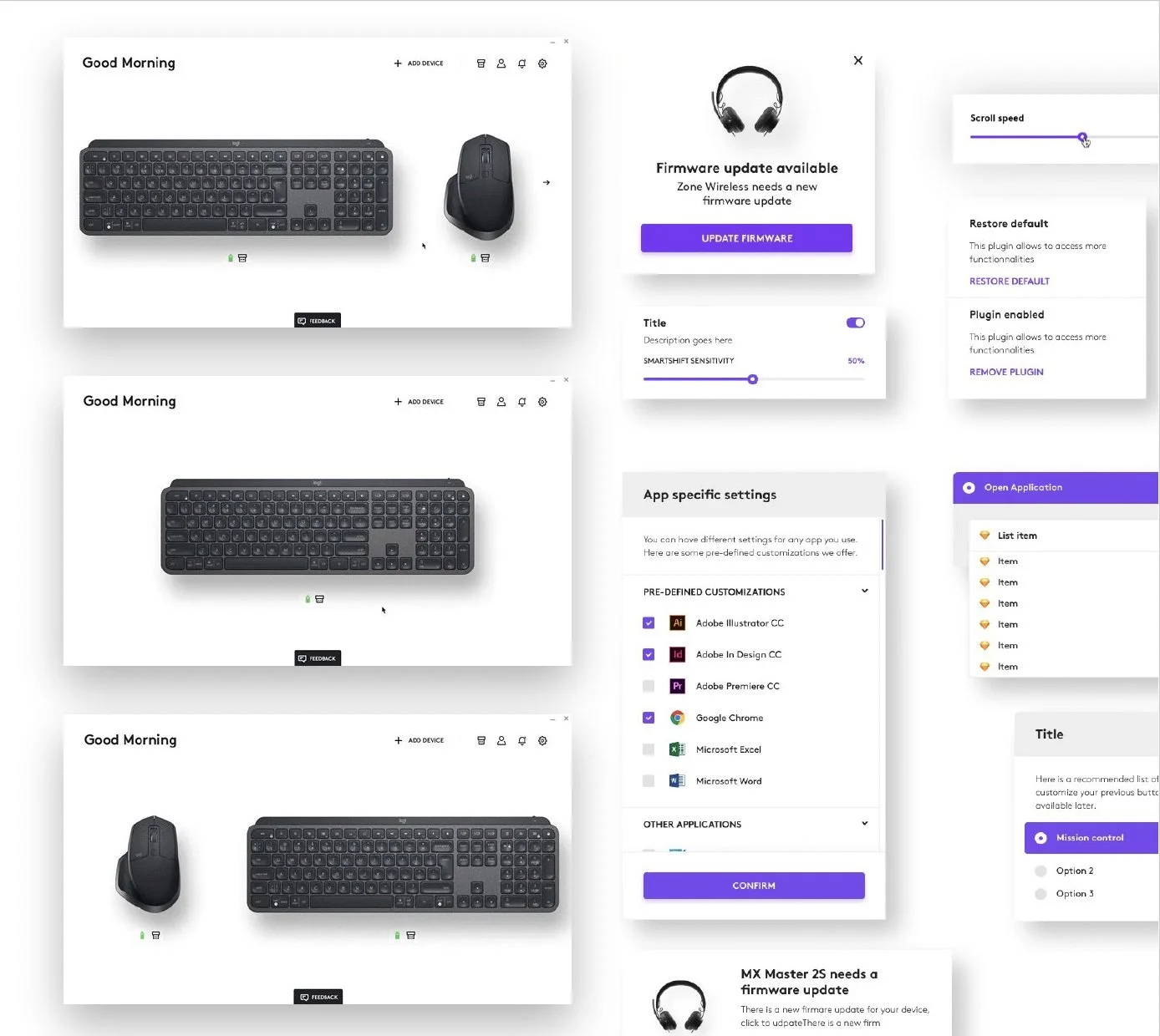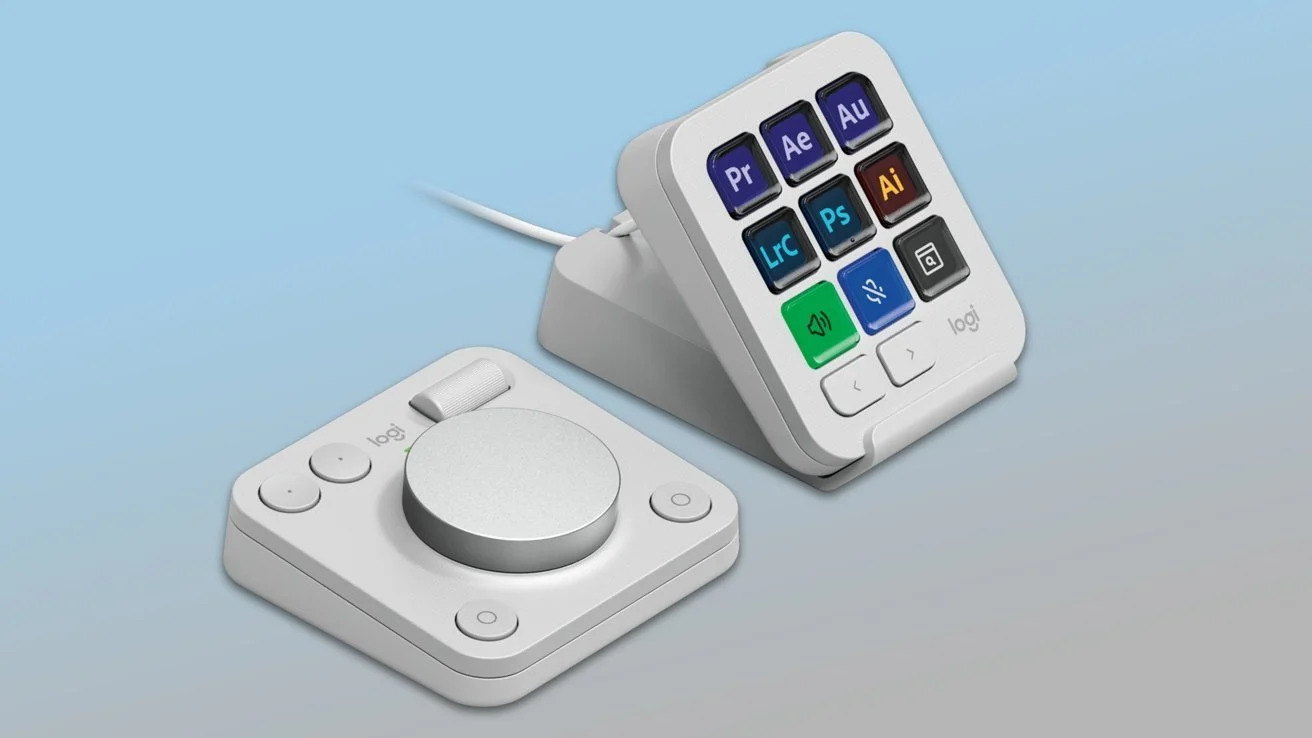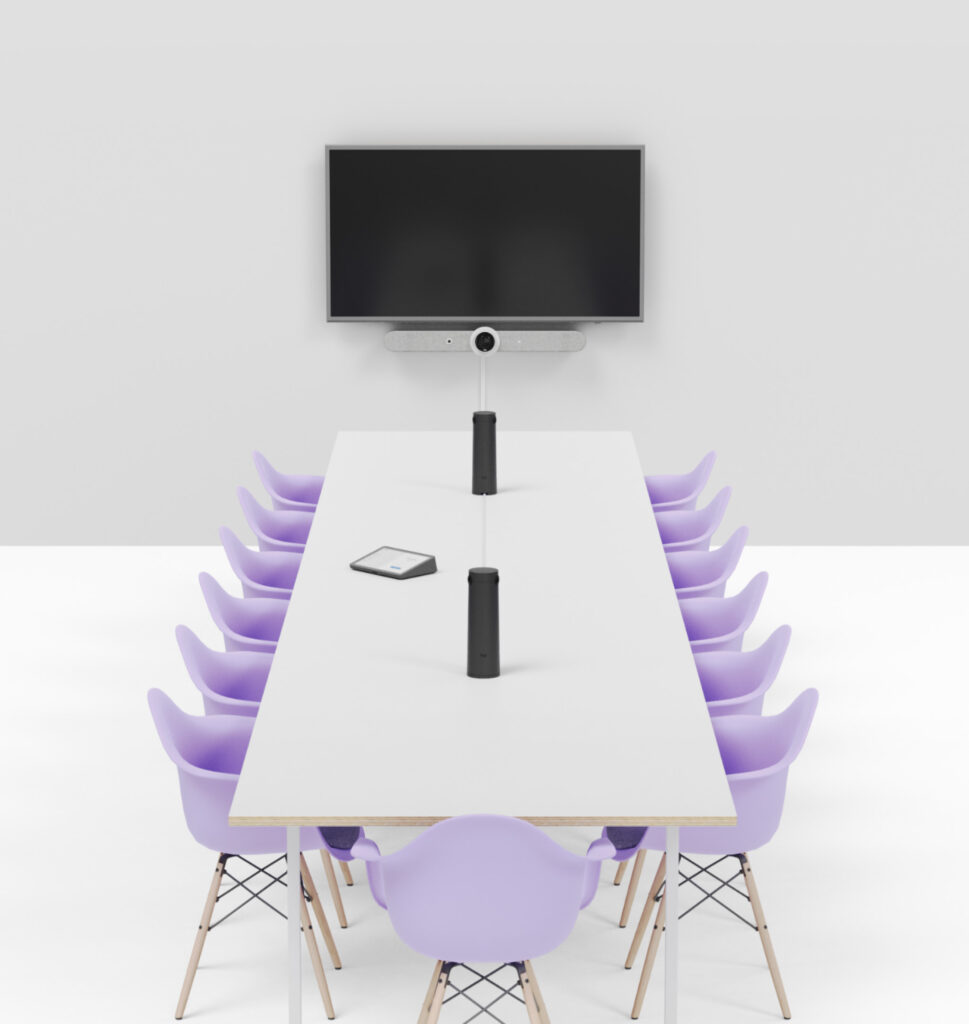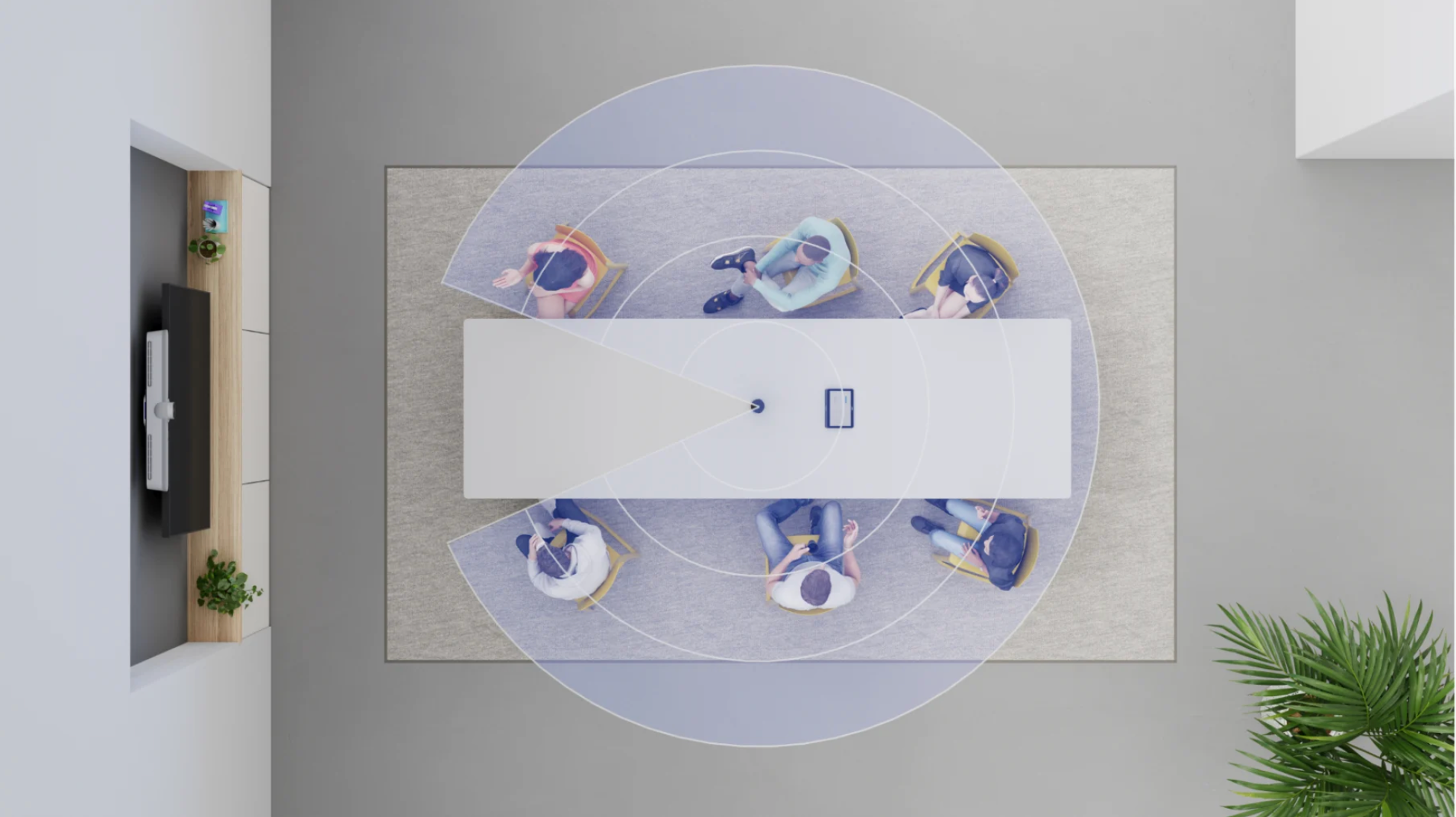Design Leadership in Action
From systems to signals — leading design in the age of intelligence
Each of these case studies reflects a different facet of my work leading design at the intersection of technology, clarity, and human experience. Whether scaling global systems at Logitech or guiding startups through Spark, my focus remains the same: make complex technology feel simple, trustworthy, and alive with purpose. From defining design languages that connect hardware and software, to orchestrating AI-powered experiences that elevate human judgment, I lead teams to turn ambiguity into alignment — and vision into velocity.
Logitech Options+ & Creative Console
Designing Platform Ecosystems that Connect Hardware + Software
Context
Built Logitech’s first unified software experience across devices, establishing the foundations of its Design Language System (DLS) and cross-portfolio UX architecture. Demonstrated how scalable systems can support both craft and speed — a model later extended across the company.
Approach
As Logitech’s portfolio grew across hardware, software, and services, our experience layer began to fragment. I led the design and rollout of Logitech Options+, a unified cross-device platform built on a shared Design Language System (DLS).
Our team’s goal was not just to modernize the interface — it was to scale design as infrastructure, connecting visual, behavioral, and technical systems so every product team could build faster with consistency and craft. I partnered closely with engineering and PM to establish system governance, token hierarchy, and integration with component libraries, ensuring the design system connected all the way to production code.
As AI-assisted design tooling emerged, we also began exploring predictive patterns to accelerate layout and content decisions, seeding the foundation for future AI-enhanced workflows.
Impact
Options+ became the standard for Logitech’s software ecosystem — the first true embodiment of the DLS across devices and platforms. It reduced design and engineering handoff time by more than 40%, enabled cross-team reuse at scale, and unified product experiences across categories. More importantly, it demonstrated how a shared design system could act as an engine of velocity, not a constraint — proving that craft and scale can coexist. This model later became the backbone for Logitech’s global design transformation and set a template for AI-ready design system governance across the organization.
Decision Highlight
The pivotal decision was to design the system for evolution, not perfection. By investing early in governance, design tokens, and team adoption, we created a living platform rather than a static asset — one capable of absorbing new inputs like AI-assisted prototyping and automated pattern detection. That shift — from design as artifact to design as system — became one of the organization’s most powerful cultural transformations.
Logitech for Business — Rally Bar + Sight
Designing Inclusive Experiences for Hybrid Collaboration
Context
Led design for the hybrid-work conference product that used AI and spatial audio to bring remote participants into the room. Focused on clarity, trust, and the human side of machine perception — ensuring technology supported connection, not distraction.
Approach
Logitech Sight was an opportunity to humanize AI in the workplace. The goal wasn’t to showcase machine intelligence — it was to restore presence and connection for remote participants in hybrid meetings. I led the design vision across hardware and software to ensure that Sight’s AI-powered camera framing and spatial audio felt intuitive, respectful, and human-centered. Working closely with engineering and product, we defined a design system for perception and feedback — how the product would show awareness, indicate decision-making, and maintain user trust while operating autonomously. Our design language emphasized transparency and predictability, helping users feel in control even when the system acted on its own.
Impact
Sight became a cornerstone of Logitech’s hybrid collaboration portfolio and one of its most ambitious AI-integrated products. It demonstrated how thoughtful UX design could translate advanced AI capabilities into emotionally credible experiences, setting a new bar for human-machine collaboration in enterprise environments. The work influenced Logitech’s broader AI strategy — shaping internal standards for AI visibility, explainability, and trust behaviors now used across the company’s conferencing ecosystem.
Decision Highlight
The most important design decision was to make AI visible but not anthropomorphic. Rather than giving the product a “voice” or personality, we defined a pattern language of signals, states, and physical gestures that communicated awareness without pretending to be human. This principle — designing AI that earns trust through clarity, not performance — became a foundational guideline for future connected products.
“Hearth” (Spark Case Study)
Designing the Smart Home That Finally Works
Context
A Spark Design Strategy case study. Defined the product vision and experience foundation for an AI-orchestrated home system built around clarity, harmony, and connection. Illustrates how design and AI can work together to enhance human context, not replace it.
Approach
Hearth began with a question: what if smart homes could finally feel human? As founder and design lead through Spark Design Strategy, I guided the concept from early research through brand strategy, user journeys, and an initial design language system. The goal was to reimagine home orchestration through AI that enhances awareness, not automation — creating a product that feels collaborative, dependable, and emotionally grounding. I defined the UX architecture, product principles, and tone framework, ensuring that every element — from setup to daily interaction — reinforced trust, clarity, and control. Rather than anthropomorphizing AI, Hearth uses contextual cues and transparent feedback to make intelligence feel present but invisible — a quiet, reliable co-pilot for the modern home.
Impact
Hearth evolved into a holistic product system concept demonstrating how design can translate complex AI technology into relatable, everyday value. The work produced a validated persona set, experience principles, and full user journey narrative, all captured in a case study that became a proof point for Spark’s AI-accelerated design methodology. The project has since shaped Spark’s design frameworks for AI-orchestrated ecosystems, influencing how we approach product definition, DLS creation, and founder decision coaching. Most importantly, Hearth showed that AI-driven design can deliver not just convenience, but connection, empowerment, and emotional resonance — the next frontier for intelligent living.
Decision Highlight
The pivotal decision was to anchor the system in human rhythm, not device logic. By designing Hearth around daily emotional states — not technical events — we created a foundation where AI supports well-being rather than chasing optimization. That choice redefined how we talk about intelligence itself: not as automation, but as empathy at scale.
ClimateUX — Stealth Sustainability App
Guiding Founders to Confident Product Decisions
Context
ClimateUX is creating a stealth sustainability app. The founder needed help clarifying product direction and content strategy to avoid building features that felt scattered or unfocused.
Approach
When the founder of a sustainability startup approached me through Spark Design Strategy, her vision was ambitious but undefined: build a product that helps businesses make better climate decisions through data. I began by reframing the challenge — not as a design sprint, but as a clarity sprint. Through workshops, diagnostic mapping, and narrative framing, I helped translate a broad mission into a tangible product strategy, experience architecture, and decision framework. We defined the core user loop, articulated design principles rooted in trust and transparency, and mapped the interactions where AI could meaningfully support—not overwhelm—human decision-making. My role extended beyond design direction: I acted as a fractional CDO, aligning founders, engineers, and advisors around a shared product story and roadmap.
Impact
Within six weeks, ClimateUX moved from concept ambiguity to a clear, actionable plan for design and development. The team gained a validated product narrative, interaction model, and visual design foundation ready for implementation. By codifying their design principles early, we prevented misalignment later — accelerating progress toward a January launch. The process became a model for Spark’s AI-accelerated product acceleration framework, showing how structured decision-making can convert founder intuition into execution clarity. For the founder, the shift was transformative: design became the connective tissue between vision, product, and business momentum.
Decision Highlight
The key decision was to define “climate intelligence” as guidance, not data visualization. By repositioning the product from a dashboard to a decision assistant, we unlocked a more meaningful role for AI — helping users act with confidence rather than interpret complexity. That single reframing changed everything: the story, the UX structure, and ultimately, the company’s ability to communicate its value.
Let’s Connect
I’m always open to conversations about how design can drive clarity, speed, and intelligence at scale. Whether you’re building a global platform or shaping a new product vision, I bring systems thinking and human-centered leadership to help teams move from complexity to confidence.










